I suppose someone decided that this week is Stargate week, as this is the second Stargate inspired tattoo that’s popped up in the geek tattoo gallery. It’s an amalgam of both the Stargate glyphs, and the world turtle mytheme.
Tag Archives: mythological-tattoos
Post navigation
Ghostly Geisha
This interesting little piece was sent in by Joey Pang of Tattoo Temple in Hong Kong. It’s no secret how much I love her work, and this piece is just another example of how awesome she is.
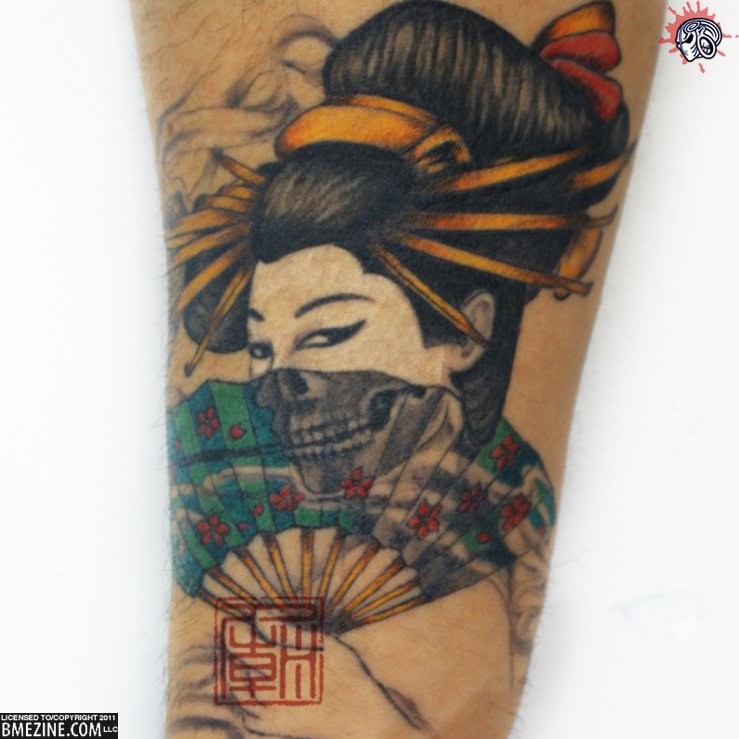
You can check out the full sized version of this photo in the oriental style tattoo gallery.
The all-seeing eye
Vincent Hocquet from Beautiful Freak Tattoo in St. Idesbald in Belgium always manages to create stunning images. This week is no different with this dotwork sleeve he sent in.

You can check out more of Vincent’s work in his BME portfolio gallery.
Beware the Gorgon
One of the most common tales from Greek mythology is that of Medusa. With her head of snakes and gaze that could turn any man to stone, she’s been recreated in film and art for centuries. Layylayy added this Medusa by Todd Noble from Black Cobra in Salisbury, MD to her leg and has since then caused anyone to look at it to stop everything they were doing and stare into her fierce gaze.
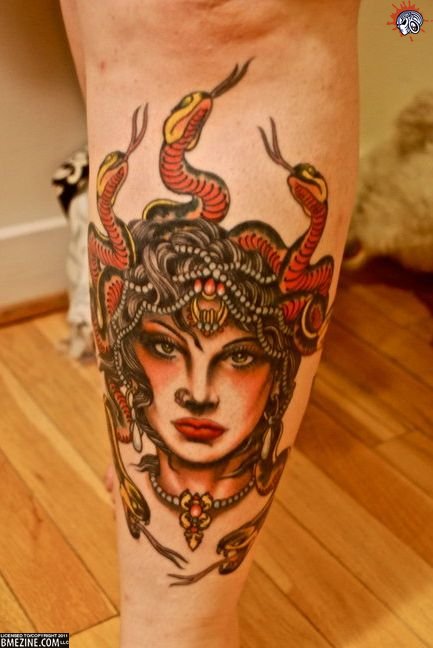
Kitsune in black
Out of the shadows comes a heavy black kitsune design by Genko from Nagoya, Japan.
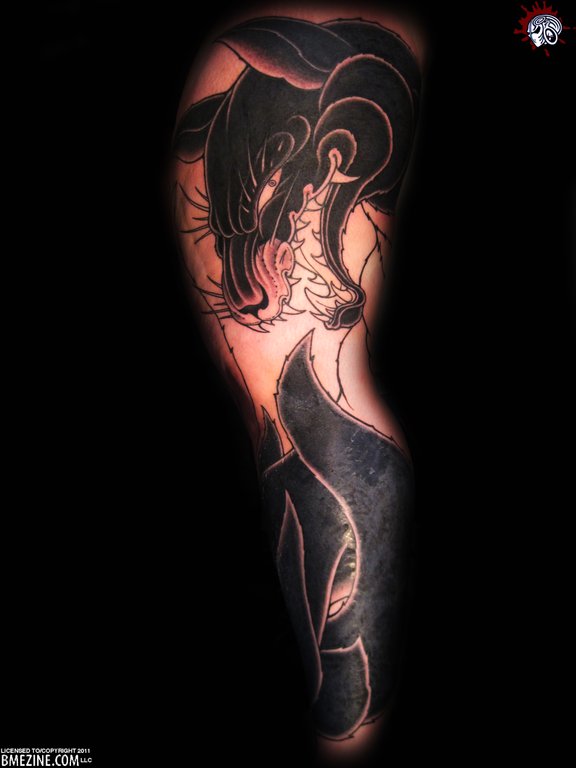
You can check out the full sized version of this menacing fox in the oriental style tattoo gallery.
Best in Show
Tattoo Hollywood has come and gone. I think I’m still trying to recover from the jet lag. I had a great time this year. This post, however, is not about me, it’s about the Best in Show award winner. Seeing as I was a crew member, I got to see a lot of the work that people were getting. I’m not lying when I say I was blown away and competition for all the contests was really stiff! The smiles on attendees faces said it all.
Unfortunately, I had to spend Sunday evening at the booth selling admission bracelets so I didn’t get to watch the contests take place that night. The judges Sunday night were Clark North, Jimmy Utah and Little Linda and the contest culminated with the “Best in Show” piece, which was a piece started and finished at the convention. While I didn’t get to see the contest, I did get to see the winner’s progress as the tattoo, which took 9 hours to complete, was worked on.
Without any further rambling, I give you this year’s Best in Show winner, none other than Katie McShady! Katie was tattooed by Japanese artist Horiren. Horiren practices tebori, the traditional Japanese method of hand tattooing. She used a tattoo machine to make the outline mainly to save on time and the rest of the tattoo was completed by hand.

Want to know more? Read on!
I was also tattooed by Horiren and Katie and I had a lot of time to compare notes, so to speak. The process was surprisingly less painful than the experience of being tattooed with a machine. I stopped by to check out the progress several times as Katie was being tattooed. She looked very zen and relaxed, iPod on, eyes closed as a crowd watched Horiren work. The photo below was taken many hours in to the tattoo and Katie is still smiling!

She didn’t use a stencil. I’m not sure if she ever does. The tattoo was drawn on by hand with a sterile marker prior to starting. Katie hardly had any swelling even after a full 9 hours of tattooing. Once finished, Horiren proclaimed, “WE FINISHED!! VERY VERY STRONG GIRL” and, as Katie says, continued to praise her strength in Japanese. Katie was given a ceremonial robe to wear and many photos were taken. Katie says she began crying because she was so overwhelmed by the experience, which she calls life changing.

Photo by Jon Arthur
These photos were taken the day of the contest, the day after Katie was tattooed.



After winning Katie was given a trophy and Horiren was given a special prize, a tattoo machine from Lucky Supply that had the Hollywood sign on it. Congratulations to Katie and to Horiren for her incredible work!
As photos come in you’ll be able to see them in the Tattoo Hollywood Gallery. If I can get a photo of Horiren’s prize I’ll update the post to include it.
Updated on September 2nd:
Better late than never right? Photo credit goes to Hiro Hara.

Falling Angel
The tattoo in this post has me stumped. It comes from the religious and mythological tattoo gallery, and when I look at it, I see two different things, yet both have similar meanings.
On one hand, I see a falling angel, which naturally evokes the tale of the Morning Star, Lucifer. Depending on which version you’re familiar with, the Lucifer myth is often tied to ambition and downfall. When Lucifer rebelled against heaven, taking on God and the angels loyal to her, his ambition led to him and his followers being thrown out of heaven, to spend eternity in hell. The artists Bosch and Dore both have created images depicting the fall, which bear a similarity to the falling angel in the tattoo.
On the other hand, I can see this being an image of Icarus, and not the happy little guy with a bow from the NES game. Like the Lucifer story, Icarus tried to reach beyond his abilities which lead to his fall, and eventual death. Only in this case, Icarus was ignoring his father’s words of warning about flying to close to the sun, and ended up having his wings melt.
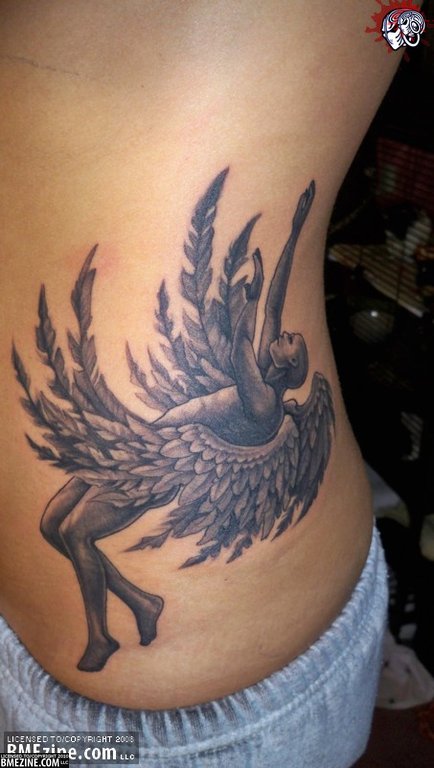
So what do you think is being depicted? Is this an angel falling from heaven, or someone who flew too close to the sun? Or is it something else entirely?
Stone by day, warriors by night
I’m probably the furthest thing from a religious scholar you will find, but during my years in university I did come across a large number of texts that were either directly tied to the church, or at least were influenced by it. Now the term “gargoyle” refers to any sculpture (usually in the form of an animal or person) that is designed to allow water to fall away from the edges of a building to prevent erosion. Over the years people have just adopted the term to apply to any decorative sculpture on the roof of a building.
The reason I bring up the religious side of gargoyles is that centuries ago, when being illiterate was the norm, the church needed ways to convey their stories and rituals to the masses. What better way to educate an illiterate crowd than through images. It was here that the myth of the gargoyle began. As the story goes, St. Romanus encountered a monster in his travels, your typical dragon type creature that breathed fire. Well when Romanus defeated the creature, he brought its body back to be burned, but discovered that the head wouldn’t burn because the dragon breathed fire and the head was adapted to heat. So he hung the head on the outside of the church to ward off evil spirits. Over time the churches would add their own stone gargoyles to the outside of the building in order to let people know that outside the church evil lurks, but inside they will be protected.
Now of course when I was growing up gargoyles were just scary looking statues that eventually came to be “cool” in my young eyes. I suppose that was aided by the Disney cartoon. Of course I’m not the only person walking the planet that enjoys looking at gargoyles. Bromley_Daz submitted this image to BME the other day, and I think it’s safe to assume he enjoys gargoyles as well.
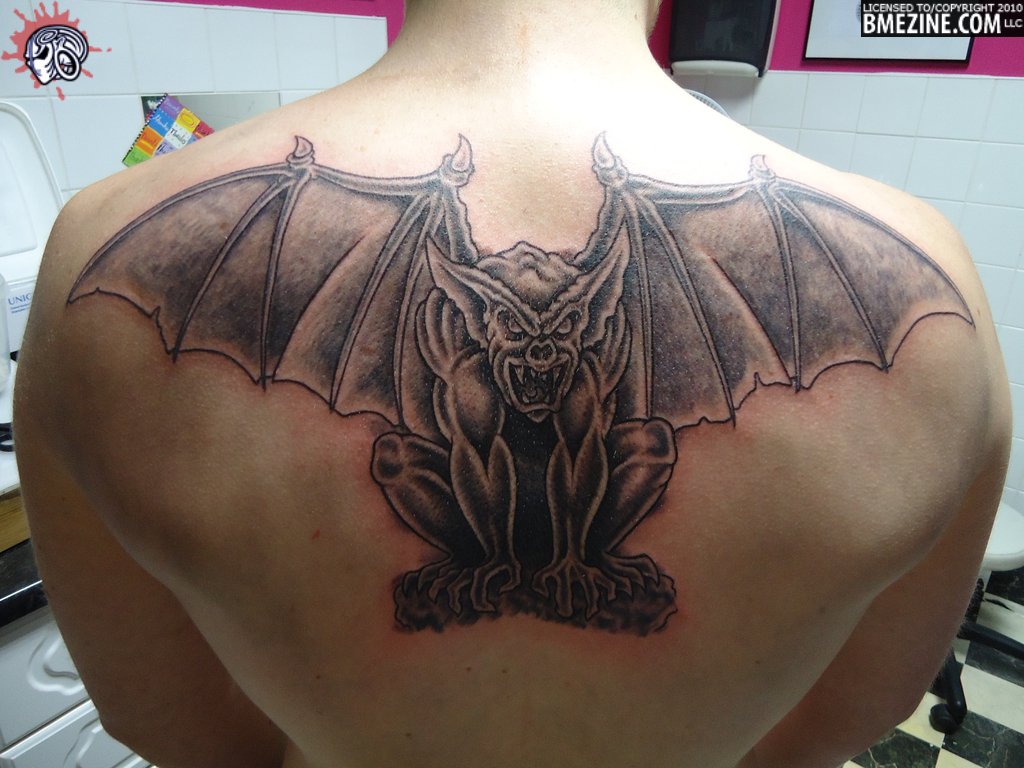
It’s always nice to see images added to the mythological and religious gallery, because often there is a good story behind the designs. This image in particular reminds me that every culture around the world has developed their own wards against evil. Be it symbols or rituals, these wards have become much more than just a repellent to evil. The gargoyle being a prime example of that. What first started as a way to protect buildings from erosion, a practice that pre-dates Christianity by centuries, eventually became a symbol of warning to people. As time passed, these statues became the guardians of the the buildings they were installed on, until eventually they were regarded primarily for their historical significance and their art.
Now while I don’t feel the need to possess any particular wards against evil, I do own a Rangda mask that hangs on my wall, that I really like the aesthetics of. How about you? Do you possess any symbols that can be attributed to warding off the evils of the world?
Lycius and the Lamia
Left to herself, the serpent now began
To change; her elfin blood in madness ran,
Her mouth foam’d, and the grass, therewith besprent,
Wither’d at dew so sweet and virulent;
Her eyes in torture fix’d, and anguish drear,
Hot, glaz’d, and wide, with lid-lashes all sear,
Flash’d phosphor and sharp sparks, without one cooling tear.
The colours all inflam’d throughout her train,
She writh’d about, convuls’d with scarlet pain:
A deep volcanian yellow took the place
Of all her milder-mooned body’s grace;
And, as the lava ravishes the mead,
Spoilt all her silver mail, and golden brede;
Made gloom of all her frecklings, streaks and bars,
Eclips’d her crescents, and lick’d up her stars:
So that, in moments few, she was undrest
Of all her sapphires, greens, and amethyst,
And rubious-argent: of all these bereft,
Nothing but pain and ugliness were left.
Still shone her crown; that vanish’d, also she
Melted and disappear’d as suddenly;
And in the air, her new voice luting soft,
Cried, “Lycius! gentle Lycius!”—-Borne aloft
With the bright mists about the mountains hoar
These words dissolv’d: Crete’s forests heard no more.–John Keats – Lamia
I really love it when a picture is submitted that has such a rich back story behind it. Tiffany George recently uploaded this image of a piece she had done. The tattoo is a recreation of John William Waterhouse’s Lamia (on her knees).
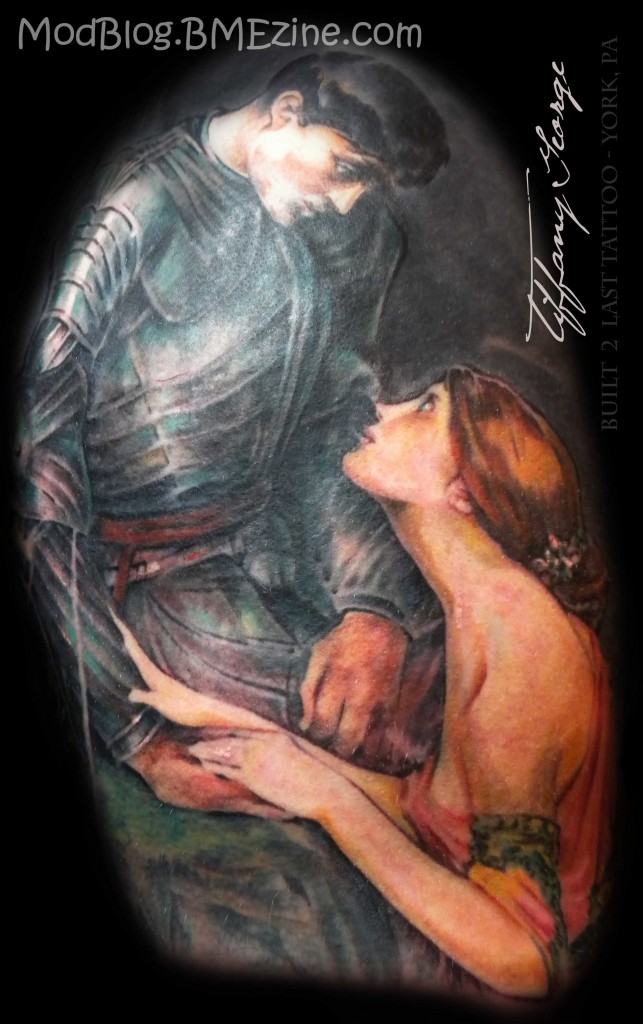
Now, the story of the Lamia stems from Greek mythology, but it has its roots buried deep in many other myths. The basics of the story is that Lamia was a beautiful woman, who had an affair with Zeus (I mean, who in Greek mythology hasn’t slept with Zeus?). Well, from their little tryst, Lamia gave birth to children. Hera, Zeus’ wife, wasn’t too pleased so she went and killed all of the children. Lamia, so torn up with grief began roaming around eating children.
From this point the myth diverges into many different stories, all depending on the time period that the story was told. The tale itself began to travel and was adopted by many other cultures as a way to warn children about being bad. Some of you may be familiar with the Baba Yaga story, or any other that involve a woman who lures children away to eat them.
You’ll note the poem that I quoted at the top of this post. Keats, one of the last romantic poets, told the story of the Lamia and Lycius. In it the Lamia is a serpent who helps the god Hermes find an invisible nymph. In return he restores her to human form, where she promptly falls in love with Lycius. The two are set to be married, but right before the ceremony Lycius’ mentor reveals the Lamia for her true self, and Lycius dies of grief. It is from this particular poem that the painter John William Waterhouse created a series of paintings depicting the Lamia, including the one that Tiffany tattooed. One key thing to note in the image is the band of green around her arm. In all of the paintings Waterhouse depicted the Lamia as a woman, yet had her draped in snake skins, which is what the green band is comprised of.
So while we’ve established the myth of the Lamia, and the later romanticism about it, it’s interesting to also note the ties it has beyond a warning to children to behave.
Now while you may not be familiar with the Lamia myth, you may recall the story of Lilith. Now the Lilith story pre-dates Christian mythology by a few centuries, going back as far as 27th century BC Mesopotamia in the Epic of Gilgamesh where Gilgamesh encounters an early version of Lilith as a serpent in a tree and slays it. In western civilization we commonly think of Lilith as being Adam’s first wife who refused to be submissive and ran away. After her departure a number of different things happen to her, all depending on what version of the tale is being told. In some she is pursued by the angels to return to the garden, and as punishment 100 children will die every day. In others she runs away to marry the archangel Samael. Regardless of the biblical related stories, the undercurrent is that Lilith was evil for leaving Adam, and at some point became serpent-like and was responsible for the deaths of children. Of course in historical terms this meant the story was a reminder that women who seek power are evil in some form.
These myths eventually led to the modern interpretation of Lilith, where she is as seen as a mother goddess, or as a being of natural power. Wiccans revere her, while those who hold true to the original myths see her as a pagan goddess of witchcraft, and a demon who will cause women to sin. No matter what your personal interpretation is, it’s safe to say that at some point in your life you may have encountered some form of either the Lamia or Lilith myths. Just take a look at movies and television, Lilith was a character on the TV show Supernatural, the Lamia was an evil spirit in Sam Raimi’s “Drag me to Hell”, the White Witch from the Narnia books is a descendant of Lilith (granted the Narnia books are all Christian allegories so this shouldn’t be a surprise), and in del Toro’s “Pan’s Labyrinth”, the Pale Man both eats children and can remove his eyes (another staple of the Lamia myth).
And even if you can say you’ve never encountered any interpretation of the myths, now that you’ve seen the tattoo and read this post, you’re no longer able to claim innocence.
Everywhere I turn all the beauty just keeps shaking me
It’s been several years since I was in Israel but after viewing the massive amount of photos submitted to BME by Kipod Tattoo Studio in Tel Aviv, I have to say, I hope I get back there! And to Michael, just one of the talented tattooists at this studio, I say this, you’re on notice buddy! If I get back to Israel, I’m coming to see you!

One more after the jump, just because.

See more in the Kipod Tattoo Portfolio.
